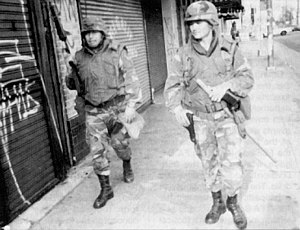Kerusuhan Los Angeles 1992
Kerusuhan Los Angeles 1992, juga dikenal sebagai Kerusuhan Rodney King, Kerusuhan South Central, Gangguan sipil Los Angeles 1992, Kerusuhan sipil Los Angeles 1992, dan Pemberontakan Los Angeles,[1] adalah serangkaian kerusuhan, penjarahan, penyerangan, dan gangguan sipil yang terjadi di Los Angeles County, California pada April dan Mei 1992. The unrest began in South Central Los Angeles on April 29 after a trial jury acquitted four officers of the Los Angeles Police Department of the use of excessive force in the videotaped arrest and beating of Rodney King. It then spread throughout the Los Angeles metropolitan area as thousands of people rioted over a six-day period following the announcement of the verdict.
| Kerusuhan Los Angeles 1992 | |
|---|---|
 4.000 Garda Nasional Tentara California melakukan patroli kota untuk menegakkan hukum. | |
| Tanggal | April 29 – 4 Mei 1992 |
| Lokasi | Los Angeles County, California, AS. |
| Sebab | Reaksi terhadap pembebasan polisi yang diadili dalam pemukulan terhadap Rodney King; kematian Latasha Harlins |
| Metode | Widespread rioting, looting, assault, arson, protests, property damage, firefights, murder |
| Jumlah korban | |
| Korban jiwa | 58 |
| Terluka | 2.383 |
| Tertawan | 11.000+ |
Referensi
Further reading
- Afary, Kamran, Performance and Activism: Grassroots Discourse After the Los Angeles Rebellion of 1992, Lexington Books, 2009.
- Assembly Special Committee To Rebuild is Not Enough: Final Report and Recommendations of the Assembly Special Committee on the Los Angeles Crisis, Sacramento: Assembly Publications Office, 1992.
- Baldassare, Mark (ed.), The Los Angeles Riots: Lessons for the Urban Future, Boulder and Oxford: Westview Press, 1994.
- Cannon, Lou, Official Negligence: How Rodney King and the Riots Changed Los Angeles and the LAPD, Basic Books, 1999.
- Gibbs, Jewelle Taylor, Race and Justice: Rodney King and O.J. Simpson in a House Divided, San Francisco: Jossey-Bass, 1996.
- Gooding-Williams, Robert (ed.), Reading Rodney King, Reading Urban Uprising, New York and London: Routledge, 1993.
- Hazen, Don (ed.), Inside the L.A. Riots: What Really Happened – and Why It Will Happen Again, Institute for Alternative Journalism, 1992.
- Jacobs, Ronald F., Race, Media, and the Crisis of Civil Society: From the Watts Riots to Rodney King, Cambridge University Press, 2000.
- Los Angeles Times, Understanding the Riots: Los Angeles Before and After the Rodney King Case, Los Angeles: Los Angeles Times, 1992.
- Song Hyoung, Min, Strange Future: Pessimism and the 1992 Los Angeles Riots, Durham: Duke University Press, 2005.
- Wall, Brenda, The Rodney King Rebellion: A Psychopolitical Analysis of Racial Despair and Hope, Chicago: African American Images, 1992.
- Webster Commission, The City in Crisis' A Report by the Special Advisor to the Board of Police Commissioners on the Civil Disorder in Los Angeles, Los Angeles: Institute for Government and Public Affairs, UCLA, 1992.
External links
Pranala luar pada artikel ini mungkin tidak sesuai dengan kebijakan atau pedoman Wikipedia. Bantulah memperbaiki artikel ini dengan membuang pranala luar yang berlebihan dan tidak sesuai. (December 2015) |
General
Wikimedia Commons memiliki media mengenai 1992 Los Angeles riots.
- The L.A. Riots: 15 Years after Rodney King from Time.com.
- Flawed Emergency Response during the L.A. riots – article by Taubman Center for State and Local Government.
- The L.A. 53 – full listing of 53 known deaths during the riots, from the L.A. Weekly.
- L.A.'s darkest days – Christian Science Monitor retrospective and interviews with victims and participants.
- "Charting the Hours of Chaos". Los Angeles Times. April 29, 2002.
- 1992: The LA riots – an anarchist perspective characterizing the riots as political uprising.
- Of Illicit Appearance: The L.A. Riots/Rebellion as a Portent of Things to Come, Lewis Gordon, Truthout, May 12, 2012
- 20 Years After the L.A. Riots, Revisiting the Rationality of Revolt, Nigel Gibson, Truthout, May 12, 2012
- The Untold Story of the LA Riot, David Whitman, U.S. News & World Report, May 23, 1993, with special emphasis on the riot's first day
Fotografi
- Urban Voyeur – black and white photographs taken during the riots.
Video dan audio
- CBS News Special Report: Beyond the Rage (aired May 1, 1992)
- Los Angeles – A City Under Fire Part 1 (news clips montage)
- Los Angeles – A City Under Fire part 3 (raw news clips)
- ABC News story including amateur video of beating incident with commentary di YouTube
- "The Radio Show" with Tom Snyder April 30 and May 1, 1992.
- ABC Nightline special Moment of Crisis: Anatomy of a Riot